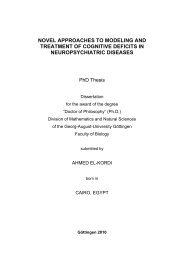Cortical and subcortical mechanisms in persistent stuttering ...
Cortical and subcortical mechanisms in persistent stuttering ...
Cortical and subcortical mechanisms in persistent stuttering ...
You also want an ePaper? Increase the reach of your titles
YUMPU automatically turns print PDFs into web optimized ePapers that Google loves.
Chapter 1 Introduction<br />
Table 1-1 Recent neuroimag<strong>in</strong>g studies reveal<strong>in</strong>g aberrant basal ganglia activity <strong>in</strong> stutter<strong>in</strong>g<br />
Reference deviations task<br />
(Chang et<br />
al., 2009)<br />
(Giraud et<br />
al., 2007)<br />
(Watk<strong>in</strong>s et<br />
al., 2008)<br />
(Lu et al.,<br />
2009b)<br />
(Lu et al.,<br />
2009a)<br />
(Lu et al.,<br />
2010)<br />
less activation <strong>in</strong> the left putamen<br />
positive correlation between severity of stutter<strong>in</strong>g <strong>and</strong> activity <strong>in</strong> the<br />
bilateral caudate nuclei<br />
overactivation <strong>in</strong> the substantia nigra, extend<strong>in</strong>g to the pedunculopont<strong>in</strong>e<br />
nucleus, red nucleus <strong>and</strong> subthalamic nucleus<br />
weaker negative connectivity from the left posterior middle temporal<br />
gyrus to the putamen, but stronger positive connectivity from the<br />
putamen to the thalamus, from the thalamus to the posterior middle<br />
temporal gyrus <strong>and</strong> anterior supplementary motor area, <strong>and</strong> from the<br />
anterior superior temporal gyrus to the preSMA<br />
altered connectivity <strong>in</strong> the basal ganglia-thalamic-cortical circuit<br />
aberrant basal ganglia-<strong>in</strong>ferior frontal gyrus/premotor area circuit<br />
repeat<strong>in</strong>g syllables or<br />
non-speech sounds<br />
(cough)<br />
overt sentences<br />
read<strong>in</strong>g<br />
overt sentences<br />
read<strong>in</strong>g sentences<br />
comb<strong>in</strong>ed with<br />
altered auditory<br />
feedback<br />
covert picture<br />
nam<strong>in</strong>g<br />
covert picture<br />
nam<strong>in</strong>g<br />
covert picture<br />
nam<strong>in</strong>g<br />
Per Alm provides a detailed theoretical framework on deficient basal ganglia circuits <strong>in</strong><br />
<strong>persistent</strong> stutter<strong>in</strong>g (Alm, 2004). He hypothesized stutter<strong>in</strong>g to arise from an impairment of<br />
the basal ganglia <strong>and</strong> cortico-striato-thalamo-cortical connections to produce tim<strong>in</strong>g cues for<br />
the <strong>in</strong>itiation of the next motor segment <strong>in</strong> speech. A recent theoretical work <strong>in</strong>corporates the<br />
aspect of sequence skill learn<strong>in</strong>g <strong>and</strong> automatization of speech (Smits-B<strong>and</strong>stra <strong>and</strong> De Nil,<br />
2007): Dysfunctional cortico-striato-thalamo-cortical connections might h<strong>in</strong>der the timed<br />
stimulus response association learn<strong>in</strong>g. Smits-B<strong>and</strong>stra <strong>and</strong> De Nil suggest that the motor<br />
memories, namely the neurochemical traces that developed due to cont<strong>in</strong>uous exposure to<br />
specific stimulus response associations, normally become <strong>in</strong>creas<strong>in</strong>gly resistant to<br />
<strong>in</strong>terference as they become <strong>in</strong>creas<strong>in</strong>gly automatized. Propos<strong>in</strong>g a deficit <strong>in</strong> automatization <strong>in</strong><br />
persons who stutter, the authors suggest a need for additional attentional resources to speech.<br />
Be<strong>in</strong>g less automated, the speech skills would be relatively weak, unstable, <strong>and</strong> more<br />
susceptible to <strong>in</strong>terference from ongo<strong>in</strong>g activity.<br />
A direct test of the basal ganglia hypothesis would require functional <strong>in</strong>terference with the<br />
activity of this <strong>subcortical</strong> structure. As the basal ganglia lie beyond the range of TMS, this<br />
method can only probe potential consequences of chronically altered basal ganglia activity<br />
with respect to cortical properties. Paired-pulse TMS as described <strong>in</strong> Appendix D, has<br />
provided valuable <strong>in</strong>sights <strong>in</strong> the modulation of cortical excitability <strong>in</strong> a number of basal<br />
ganglia disorders, <strong>in</strong>clud<strong>in</strong>g Park<strong>in</strong>son’s disease, Chorea <strong>and</strong> Gilles de la Tourette <strong>and</strong><br />
23



